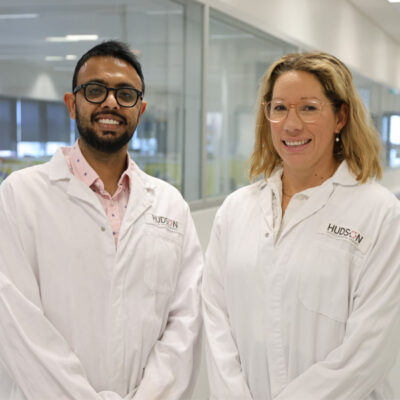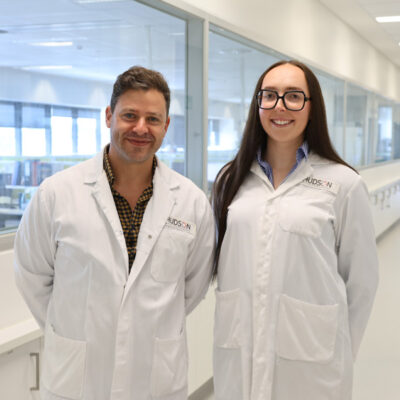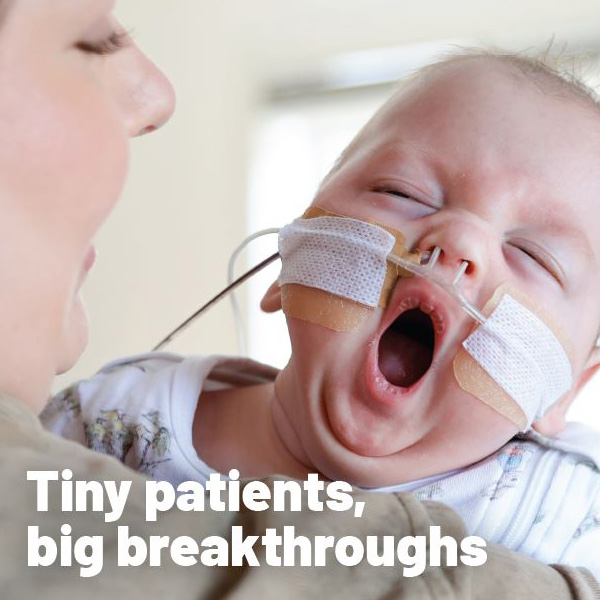Simple ‘sleep hormone’ skin patch could protect at-risk newborns
By Hudson Institute communications
A simple, cheap treatment of a skin patch containing a naturally occurring ‘sleep hormone’ could soon help to protect newborn babies from brain damage caused by oxygen deprivation at birth.

A recent study, led by PhD student Dr James Aridas and Associate Professor Suzanne Miller in The Ritchie Centre, Hudson Institute of Medical Research, is paving the way for a treatment that could transform the way babies starved of oxygen at birth are treated around the world.
The preclinical findings have been published in the May 2018 issue of Journal of Pineal Research.
“Being born without enough oxygen at birth (perinatal asphyxia) can cause death or lead to severe brain damage and it affects millions of babies each year. There is currently no available treatment that can be used to protect the brain in most of these babies,” Dr Aridas says.
What is melatonin?
- Melatonin is a ‘sleep hormone’ that is naturally produced by the body in the pineal gland and helps us to rest.
- Levels of melatonin in the body fluctuate with circadian rhythms within a 24 hour period and are at their highest at night, before and during sleep.
- Melatonin has potent antioxidant and anti-inflammatory properties.
- Melatonin is sometimes taken in tablet form or as a skin patch in adults, for example to counter the effects of jet lag.
“We hope that a simple, safe and effective melatonin skin patch could be the key to improving the lives of millions of babies around the world who are born starved of oxygen, from world-class neonatal intensive care units to rural India.”
Each year worldwide, up to four million babies suffer a difficult birth that results in perinatal asphyxia. Of these infants, a quarter will die and a quarter will survive, but are then likely to have permanent disabilities.
In this study, the researchers applied melatonin skin patches in a preclinical model of birth asphyxia. The patches released 60mg of melatonin in the 24 hours after birth.
“We found that melatonin protects the brain against an acute lack of oxygen, by reducing harmful free radicals and inflammation, which in turn protects neuronal development and results in better neonatal outcomes,” Dr Aridas says.
“Like a set of scales nearly toppling over from too much weight on one side, the brain is overwhelmed by damaging products of oxygen deprivation. Melatonin helps to ‘re-balance’ the scales and provides the body with the ability to fight against these damaging products.”
Dr Atul Malhotra, a member of the study team and a neonatologist at Monash Children’s Hospital, is now pursuing how this therapy would be best implemented in low resource birth settings in rural India.
The study was a collaboration with the Monash Children’s Hospital, Monash Health, Monash University, Murdoch Children’s Research Institute and The Royal Children’s Hospital. This research was supported by the Bill & Melinda Gates Foundation and the National Health and Medical Research Council (NHMRC).
Contact us
Hudson Institute communications
t: + 61 3 8572 2697
e: communications@hudson.org.au
About Hudson Institute
Hudson Institute’ s research programs deliver in three areas of medical need – inflammation, cancer, women’s and newborn health. More
Hudson News
Get the inside view on discoveries and patient stories
“Thank you Hudson Institute researchers. Your work brings such hope to all women with ovarian cancer knowing that potentially women in the future won't have to go through what we have!”






